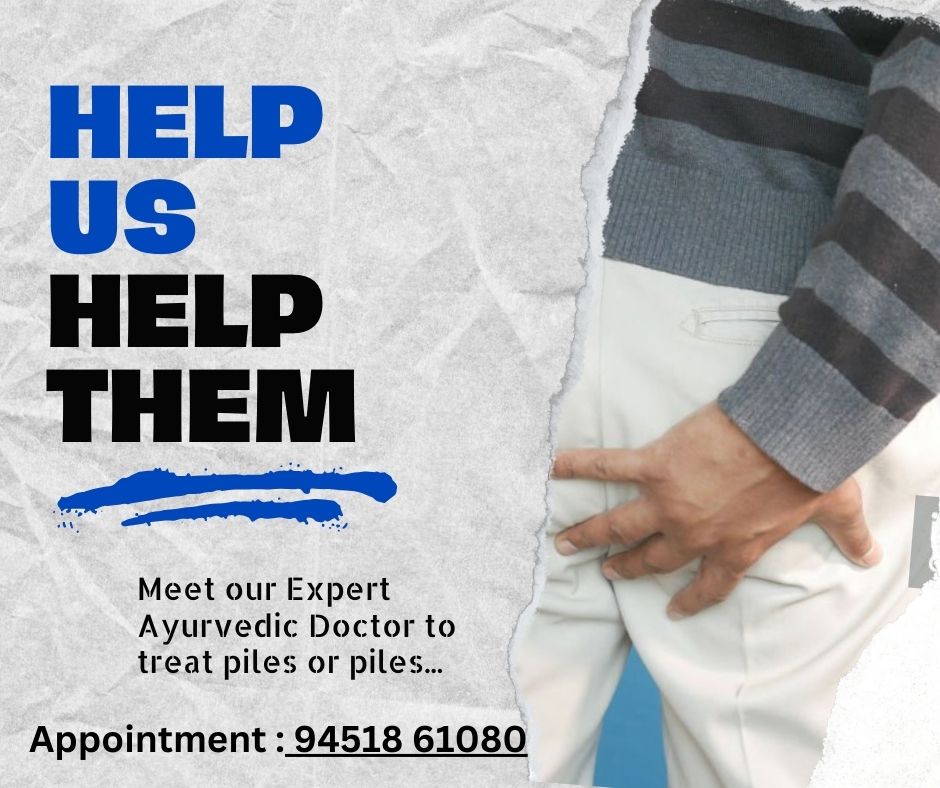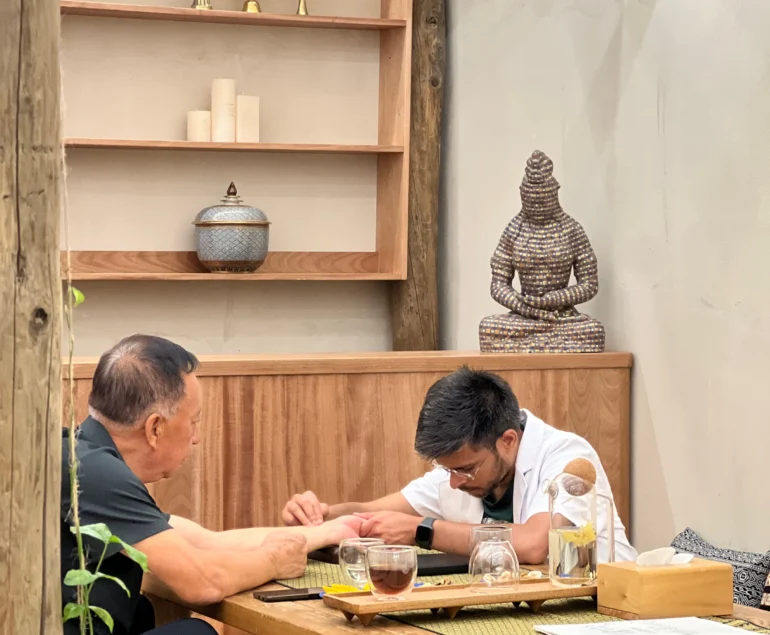Piles, or hemorrhoids, are swollen veins in the lower part of the rectum or anus. In Sanskrit, this condition is referred to as अर्श (Arsha). These swollen veins can cause discomfort, pain, or itching in the anal region. Piles can occur inside the rectum (internal piles) or outside the anus (external piles). In some cases, internal piles may protrude outside, known as prolapsed hemorrhoids.
Piles are very common in India, especially among adults due to factors like poor diet, sedentary lifestyles, and lack of awareness. The good news is that with timely intervention, piles can be managed effectively.
Types of Piles
There are two main types of piles:
1. Internal Piles (आंतरिक बवासीर): These occur inside the rectum and are usually painless but may cause bleeding during bowel movements.
2. External Piles (बाहरी बवासीर): These develop under the skin around the anus and can be painful, itchy, or swollen.
In some cases, internal piles can prolapse (slip outside the anus), causing additional discomfort.
Causes of Piles
Piles can develop due to various reasons, many of which are linked to lifestyle and dietary habits common in India. Here are the main causes:
1. Chronic Constipation (कब्ज): Straining during bowel movements due to hard stools puts pressure on the veins in the rectum, leading to piles.
2. Low-Fiber Diet: A diet low in fiber (found in fruits, vegetables, and whole grains) can cause constipation, increasing the risk of piles.
3. Sedentary Lifestyle: Sitting for long hours, especially in jobs or while using mobile phones, reduces blood flow to the pelvic area, contributing to piles.
4. Pregnancy: Many women develop piles during pregnancy due to increased pressure on the pelvic veins.
5. Obesity: Excess body weight puts pressure on the rectal veins, leading to swelling.
6. Spicy and Oily Food: In India, consuming spicy or oily foods like fried snacks or excessive masala can irritate the digestive system and worsen piles.
7. Lack of Hydration: Not drinking enough water leads to hard stools, making bowel movements difficult.
8. Chronic Diarrhea: Frequent loose motions can also irritate the anal area, causing piles.
9. Lifting Heavy Objects: Regularly lifting heavy weights can strain the pelvic region, increasing the risk of piles.
Symptoms of Piles
The symptoms of piles can vary depending on the type and severity. Common signs include:
• Bleeding: Bright red blood during or after bowel movements (often seen on toilet paper or in the toilet bowl).
• Pain or Discomfort: Especially during bowel movements or while sitting for long periods.
• Itching or Irritation: A constant urge to scratch the anal area.
• Swelling or Lumps: A noticeable lump or swelling near the anus, which may be painful.
• Mucus Discharge: A sticky discharge from the anus.
• Feeling of Incomplete Bowel Movement: A sensation that the bowels are not fully emptied.
If you notice these symptoms, especially bleeding, consult a doctor to rule out other serious conditions like anal fissures or colorectal issues.
Diagnosis of Piles
If you suspect you have piles, visit a doctor, preferably a proctologist or general surgeon. They may perform:
1. Physical Examination: The doctor will check the anal area for lumps or swelling.
2. Digital Rectal Exam: A gloved finger is used to feel for abnormalities inside the rectum.
3. Proctoscopy or Sigmoidoscopy: A small tube with a camera is used to examine the rectum for internal piles.
In India, many people feel shy about discussing such issues, but early diagnosis can prevent complications. Don’t hesitate to seek medical help—स्वास्थ्य ही धन है (Health is wealth).
Treatment Options for Piles
Piles can often be managed with simple remedies, but severe cases may require medical intervention. Here are the treatment options:
1. Home Remedies and Lifestyle Changes
For mild piles, you can try these natural remedies:
• High-Fiber Diet: Eat more fruits (like bananas, apples), vegetables (like spinach, carrots), and whole grains (like oats, brown rice). Fiber softens stools, making them easier to pass.
• Stay Hydrated: Drink at least 8-10 glasses of water daily to prevent constipation.
• Sitz Bath (गर्म पानी का स्नान): Sit in a tub of warm water for 15-20 minutes, 2-3 times a day, to reduce swelling and pain.
• Avoid Straining: Don’t push too hard during bowel movements. Take your time.
• Use Natural Ointments: Apply aloe vera gel or coconut oil to soothe itching and inflammation.
• Triphala: This Ayurvedic remedy (a mix of three fruits—Amalaki, Bibhitaki, and Haritaki) helps improve digestion and relieve constipation.
2. Medications
• Over-the-Counter Creams: Ointments like Anovate or Pilex can reduce pain and swelling.
• Laxatives: Doctors may prescribe stool softeners to ease bowel movements.
• Painkillers: For temporary relief from pain, but avoid overuse.
• Painkillers: For temporary relief from pain, but avoid overuse.
3. Ayurvedic Treatments
In India, Ayurveda offers effective remedies for piles:
• Jatyadi Oil: Applied locally to reduce inflammation.
• Arshoghni Vati: An Ayurvedic tablet to shrink piles and reduce bleeding.
• Kutajghan Vati: Helps control diarrhea and improve digestion.
Consult an Ayurvedic practitioner for personalized advice.
4. Medical Procedures
For severe or persistent piles, doctors may recommend:
• Rubber Band Ligation: A band is placed around the base of the pile to cut off blood supply, causing it to shrink.
• Sclerotherapy: A chemical is injected to shrink the piles.
• Hemorrhoidectomy: Surgical removal of large or prolapsed piles.
• Stapled Hemorrhoidopexy: A less painful surgery to reposition and fix internal piles.
• Laser Treatment: A modern, minimally invasive option to remove piles with less pain and faster recovery.
5.Role of Ksharsutra in Piles Treatment
Ksharsutra (क्षारसूत्र) is a traditional Ayurvedic procedure highly effective for treating piles, especially in India. It involves using a medicated thread (sutra) coated with herbal alkaline substances (kshar) to treat piles without major surgery. Here’s how it works:
• Procedure: Under local or spinal anesthesia, the doctor threads the Ksharsutra through the base of the pile. The medicated thread gradually cuts through the pile, reduces blood supply, and promotes healing. The alkaline coating also helps dissolve unhealthy tissue and prevents infection.
• Benefits:
• Minimally Invasive: No large incisions, reducing recovery time.
• Low Recurrence Rate: Studies show Ksharsutra has a lower chance of piles returning compared to some surgeries.
• Cost-Effective: Affordable, especially in India, compared to modern surgeries like laser treatment.
• Ayurvedic Advantage: Combines natural herbs like turmeric, guggul, and apamarga, aligning with India’s holistic healing traditions.
• Recovery: The thread is replaced weekly, and complete healing may take 3-6 weeks, depending on the case. Patients can resume normal activities within a few days.
• Suitability: Ideal for internal and external piles, especially grades II and III. It’s also effective for complex cases like fistulas and recurrent piles.
• Precautions: Performed by trained Ayurvedic surgeons, it requires proper hygiene and follow-up care to avoid complications like infection.
Ksharsutra is widely practiced in India, especially in Ayurvedic hospitals, and is a preferred choice for those seeking a blend of traditional and effective treatment. Consult an experienced Ayurvedic practitioner to assess Ksharsutra is suitable for you.
Prevention Tips for Piles
As the Sanskrit saying goes, निदानं परिहारः (Prevention is better than cure). Here are practical tips to prevent piles:
1. Eat a Balanced Diet: Include fiber-rich foods like मूली (radish), पालक (spinach), and दलिया (porridge). Avoid excessive spicy or junk food.
2. Stay Active: Exercise regularly, even if it’s just a 30-minute walk or yoga (like Pavanamuktasana to improve digestion).
3. Avoid Prolonged Sitting: Take breaks if you have a desk job or sit on hard surfaces for long.
4. Maintain Hygiene: Clean the anal area gently after bowel movements to prevent irritation.
5. Don’t Delay Bowel Movements: Go to the bathroom when you feel the urge to avoid straining later.
6. Manage Weight: Keep your body weight in check to reduce pressure on the pelvic veins.
When to See a Doctor
While mild piles can be managed at home, consult a piles doctor if you experience:
• Persistent bleeding during bowel movements.
• Severe pain or swelling that doesn’t improve.
• A lump that doesn’t go away.
• Symptoms lasting more than a week despite home remedies.
In India, many people delay treatment due to embarrassment, but timely care can prevent complications like thrombosed piles (clotted blood in piles) or fistulas.
Myths and Facts About Piles
Myth: Piles are caused by sitting on hot surfaces.
Fact: Piles are caused by pressure on rectal veins, not temperature.
Myth: Spicy food directly causes piles.
Fact: Spicy food can irritate existing piles but doesn’t directly cause them.
Myth: Only older people get piles.
Fact: Piles can affect people of all ages, especially due to modern lifestyles.
Living with Piles
Piles can be uncomfortable, but with the right care, you can lead a normal life. Focus on a healthy diet, regular exercise, and proper hygiene. In India, where spicy food and sedentary jobs are common, small changes like drinking more water and eating fiber-rich रोटी-सब्जी can make a big difference.
If you’re hesitant to discuss piles, remember that it’s a common condition, and doctors are trained to handle it with care. As the Hindi proverb says, लाज छोड़ो, स्वास्थ्य जोड़ो (Let go of shame, embrace health).
Conclusion
Piles (बवासीर or अर्श) may seem like a daunting condition, but it’s manageable with awareness and care. By adopting a fiber-rich diet, staying hydrated, and seeking timely medical help, you can prevent and treat piles effectively. Whether you opt for home remedies, Ayurvedic treatments, or modern medical procedures, the key is to act early.
For more health tips or to consult a doctor, visit your nearest clinic or trusted healthcare website. Stay healthy, stay happy—स्वस्थ रहें, मस्त रहें!



